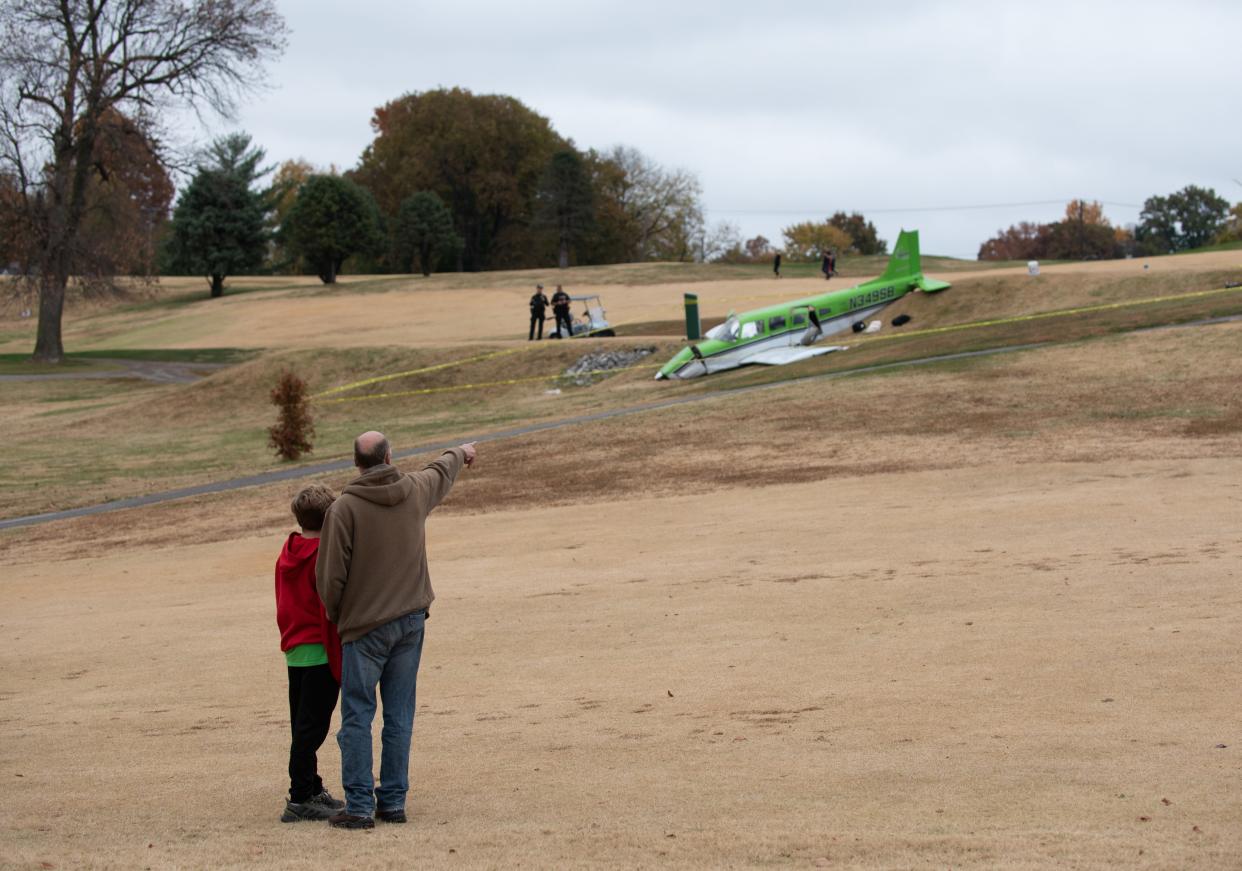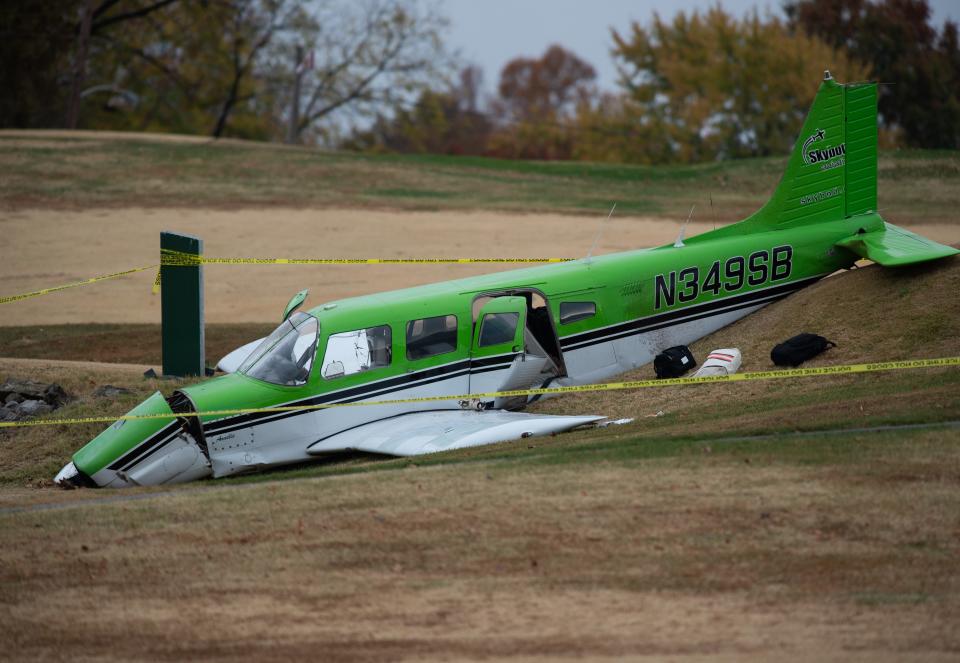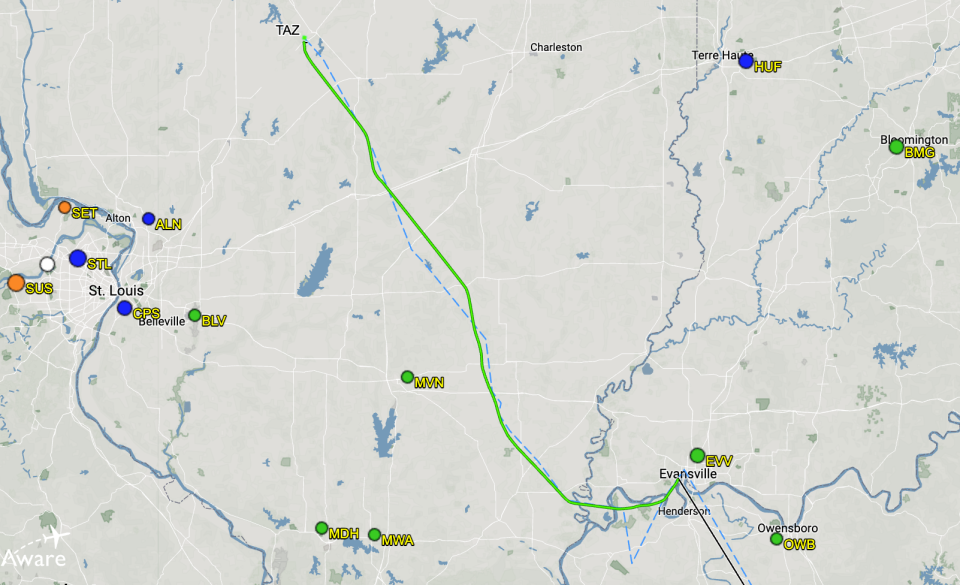Exact cause of plane's forced landing at Evansville golf course remains a mystery

EVANSVILLE — A federal investigation failed to identify the exact cause of an aircraft’s 2022 crash landing at Helfrich Hills Golf Course in Evansville – even though the pilot of the single-engine plane described suffering a total loss of engine power after he and three passengers were forced to unexpectedly descend from an altitude of 7,000 feet.
That revelation came in the National Transportation Safety Board's final report detailing the agency’s conclusions about the accident, which seriously injured the pilot, 43-year-old Nathan Butcher, and left Butcher’s wife and one of his children with minor injuries.
The Oct. 30, 2022, forced landing severely damaged the aircraft and stranded it near hole 17 at Helfrich Hills Golf Course on Evansville’s West Side.
In Butcher's official description of the forced landing, which the NTSB published along with other information pertaining to the incident, he wrote that he and his family had rented the Piper in Atlanta, Georgia, as they had many times before, to visit family in Illinois.
Butcher said he fueled the plane at Taylorville Municipal Airport to begin the return flight home. They planned to first land at Music City Executive Airport in Nashville, Tennessee, to take a break before continuing on to Atlanta.
"My wife had a friend who lived nearby KXNX and their 10-year-old son was interested inbecoming a pilot someday," Butcher wrote in the Event Summary Description. "We had arranged to meet their family there and take their son up for an introductory flight."
When Butcher took off in Taylorville, Illinois, with his wife and two children in tow and climbed to an initial cruising altitude of 5,000 feet, all seemed normal.
But according to the aviation tracking firm FlightAware, data it received from the plane’s transponder showed it diverting from Butcher’s planned route near the confluence of the Wabash and Ohio rivers in Posey County.
That diversion followed an unusual change in the aircraft’s performance about one hour and 10 minutes into the flight and at an altitude of approximately 7,000 feet, with Butcher reporting a “shake” and “abnormal indications” for the engine’s No. 3 cylinder, the NTSB reported.
“The engine smoothed out and ran normally for a few minutes,” agency investigators wrote in their final report. “The engine then surged momentarily to full power before returning back to its previous power setting."
Butcher later wrote that he told his wife to prepare herself and their children "for a precautionary landing where we would have the engine inspected."
He asked flight controllers to provide him with a direct route to Evansville Regional Airport due to the engine trouble and, out of an abundance of caution, Butcher said he radioed in the number of "souls on board and fuel remaining."
Pilot describes rapid descent into Evansville: Ohio River and interstate were possible landing sites
A worrying but manageable in-flight situation appeared to deteriorate into a crisis as the Piper descended through 2,500 feet of altitude just 8 miles southwest of EVV.
“The pilot reported hearing ‘the unmistakable sound of three thuds… and engine power was lost,’” the NTSB's final report goes on to state. “The pilot attempted to restart the engine but was unsuccessful.”
As Butcher lost altitude at a rate of 1,100 feet per minute and broke through a layer of clouds, he saw EVV for the first time and later wrote that he realized "there was no chance of making the field."
Butcher said he considered landing in the Ohio River or on an interstate. According to Butcher's official account, air traffic control in Evansville informed him there was a private, grass landing strip three miles from his position, but he could not see it.
"I was descending in excess of 1,000 FPM (feet per minute) and options were limited, and we were over a residential community," Butcher wrote. "I spotted a golf course ahead to the right and maneuvered towards it."
A group of local teens and Helfrich Hills regulars witnessed what happened soon after as the green-and-white Piper drew closer and closer to the golf course, telling the Courier & Press in 2022 they couldn’t believe what was unfolding.
"All of a sudden we just hear a loud bang,” Max Renshaw, one of the teenagers, said. “And all three of us drop our bags and we rush over the hill. And sure enough, the plane has crashed.”
Renshaw said his group dialed 911, and a dispatcher told them the authorities had already been notified that a small aircraft was experiencing engine trouble.

NTSB lists ‘total loss of engine power’ as 'probable cause' of crash, though no mechanical faults found
The loud bang Renshaw heard came as the Piper hit the turf with its flaps down and landing gear extended, according to the NTSB’s investigation. The aircraft slid approximately 280 feet before it came to a halt near hole 17 at Helfrich Hills Golf Course.
While Butcher had described problems with the aircraft’s engine in detail, the NTSB failed to turn up any pre-crash malfunctions that could have caused the Piper to crash land. Despite the lack of a clear mechanical explanation, the agency still attributed the “probable cause” of the incident to “a total loss of engine power.”
“Given the available evidence for this accident investigation, the reason for the total loss of engine power could not be determined,” the NTSB’s final report states.
During the NTSB’s investigation, agency personnel removed the Piper’s engine from the airframe and conducted a series of tests, which all returned normal results. A borescope examination of the engine’s cylinders was, in the NTSB’s telling, “unremarkable.”
Data pulled from the aircraft’s J.P. Instruments EDM-900 engine monitor also “showed no abnormalities during flight, including at the time of the reported engine issue,” the investigation found.

The NTSB report didn't state what may have complicated investigators’ efforts to identify mechanical problems within the engine or fuel and oil systems. The NTSB also didn't clarify if damage incurred during the forced landing could have obscured any pre-crash malfunctions.
The Piper aircraft in question, bearing a tail number of N349SB, was manufactured in 1977 and registered by Skyfusion II LLC in Atlanta, according to FlightAware. Skyfusion LLC lists its headquarters at an address located on Dekalb-Peachtree Airport property.
Butcher later wrote that he's a member of Atlanta-based Skybound Aviation’s flying club and had rented the Piper for several years, racking up nearly 50 flight hours behind its yoke. Logs obtained by the Courier & Press from FlightAware show the rental aircraft made more than 170 successful flights just in 2022.
The vast majority of the flights centered around the Atlanta metro area.
More: Lush, green grass awaits players again at Helfrich Hills Golf Course after restoration
In his written report, Butcher detailed the moments just before, and after, he utilized Helfrich Hill Golf Course’s wide-open green spaces as an emergency runway.
“It was a hard landing,” Butcher wrote. “Paneling from the overhead came down along with wires, and anything loose in the cabin was thrown about. As the aircraft came to a stop, I yelled “IS EVERYBODY ALIVE?”
Butcher said he got himself and his family out of the wrecked airplane, and they walked a short distance away in case of a fire. They laid down in the soft grass. Soon, the teenage golfers arrived and asked if they needed any help.
This article originally appeared on Evansville Courier & Press: NTSB releases final report on Evansville golf course plane crash

